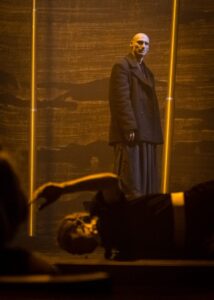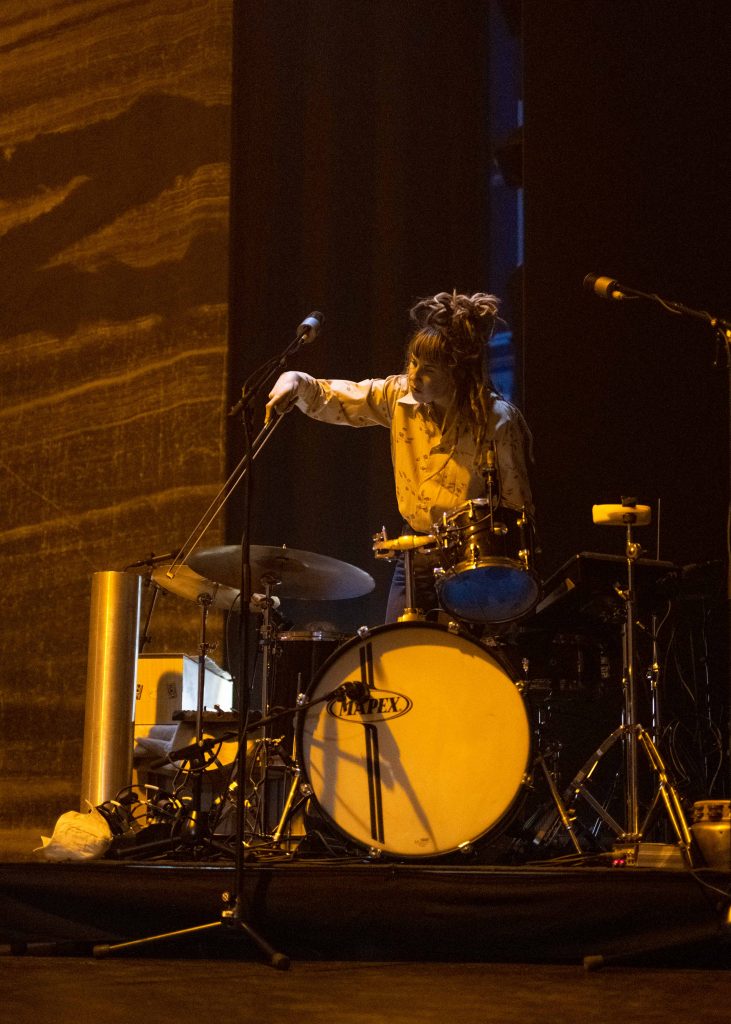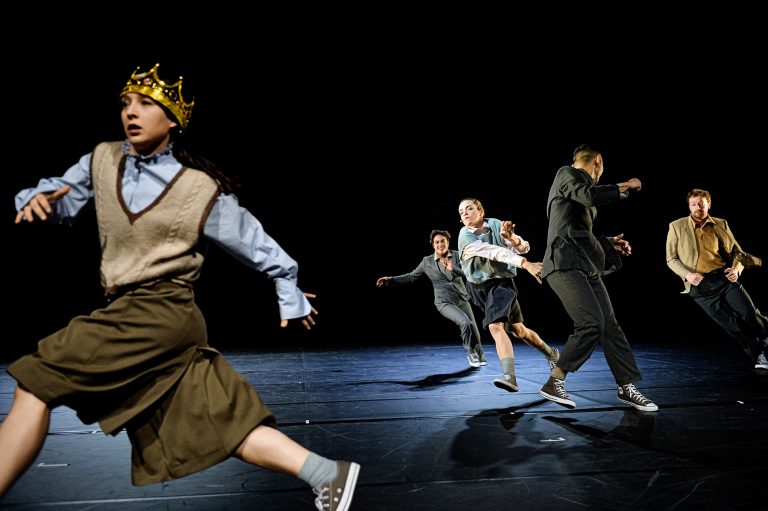Let's Embark On This Experience
Sisters, we are made of iron. Born from the same bloody womb of our mothers and killed by the same sharp dagger of men. We are witches, sorceresses that burned under the inquisitor’s watch; those who envy our power.

Welcome to Witch Hunt. This multidisciplinary performance by NITE was just something else. They never cease to impress me with their experimental, progressive, and insightful theatre. In their newest performance, what surprised me the most was that it didn’t matter whether you like this kind of theatre or not, you just dived into this sublime piece, because Witch Hunt was not just a performance, it was a whole experience.
As I approached the Stadsschouwburg (Groningen) I saw that the building was illuminated with projections: the company’s logo, some pictures, different colours. I didn’t even enter the theatre and my attention was already caught by the performance – so much so that I almost hit a bike because I wasn’t looking. Arriving in my seat, I realized it was going to be a difficult night: the play was mainly in Dutch and because I was under the first balcony, I had to contort myself to see the subtitles that were screened at the top of the proscenium. But even the pain in my neck couldn’t stand in the way of being fully immersed this evening.


The story was about an archaeologist, Esther (Sarah Janneh), specialized in the Greek figure of Hecate. Esther returned to the village she was born to work on an excavation. Forced to confront her past, she needed to face the suicide of her mother, a traditional village that hadn’t changed, and judgments of her life choices. Once at the excavation site, the past – an ancient past – came to life and offered new insights into Esther’s life: 500 years and a lot had changed. The characters that lived in the present had a counterpart in the past. In this timeframe, Esther was the unknown stranger of the village instead of the prodigal daughter. Everything was different. Yet, it remained very much the same.
The story was about an archaeologist, Esther (Sarah Janneh), specialized in the Greek figure of Hecate. Esther returned to the village she was born to work on an excavation. Forced to confront her past, she needed to face the suicide of her mother, a traditional village that hadn’t changed, and judgments of her life choices. Once at the excavation site, the past – an ancient past – came to life and offered new insights into Esther’s life: 500 years and a lot had changed. The characters that lived in the present had a counterpart in the past. In this timeframe, Esther was the unknown stranger of the village instead of the prodigal daughter. Everything was different. Yet, it remained very much the same.
They locked us in corsets, rooms, habits, patterns, social rules. They forced our silence because they were afraid of our acid words.
One of the characters, however, differed from the rest in that she remembered Esther across times. It was Eleonora (Bien de Moor), who was representative of the mythological figure of Hecate. In present times, she was the crazy old lady of the village. In the past, she became the proper witch, with all the characteristics a witch must have.
Eleonora sparked my curiosity with the dead dog she carried around and her mystical comments on Esther’s heavy shoulders. The different symbols led me to research more on Hecate, as I didn’t know much about this Greek goddess. It turns out that NITE did their research for this performance, as all possible associations with the character are represented. Hecate is the goddess of wildlands – thus the sand on stage. She is associated with light – hence Eleonora’s fascination with the twilight. She is considered a liminal goddess – explaining her memory of Esther, serving as a connection point between past and present. Hecate’s sacred animal is a dog, the same she used for sacrifices and the same Eleonora carried around dead. The goddess’s association with childbirth illuminated the presence of the themes of pregnancy, as in the performance Eleonora helped one character to give birth and the other to have an abortion. She is associated with witchcraft and the force of the Feminine Sacred: so what better figure to represent this goddess than the woman who united all the village’s women, only to be accused of being a witch?
To highlight the theme of witchcraft, the performance used different means of putting the spectators in a trance. A hypnotic experience that submerged you in the story.

First, there is the use of language that entangled us in not only the narrative, but all the hidden meanings and implicit images carried in the poetic sentences. The English and Dutch dialogues were enunciated in a rhythm that was almost like a song, especially in the last part. I know that I don’t understand Dutch, that translations don’t give the exact significance and that I lose the richness of the sounds and nuances of a language. But Bien de Moor can make even the ugliest and (to me) meaningless Dutch word sound like the most beautiful thing ever said. The rhythm of her words, the modulation of her tone, the subtlety of her pauses, the transitions from humour to drama… You should’ve been there to hear. It was simply delightful.
Then, there was the use of lighting. Oh, the lights… Just the lights were a show by itself, I promise you. From the use of dramatic spotlights to the colour scheme of the flame red that ignited the stage on the witch-burning scene, they were not only meaningful to the narrative but also wrapped our eyes in a profusion of images. The best example I can think of is at the very start. From the silent, still stage, we saw dancers entering the stage dancing to loud, fast-paced music. To accompany them, strobe lighting (flashes of light) only allowed us to see a fragmented version of their movements. From dark to light, from light to dark, it pulled you in through a clear statement that the show had begun.
And yes, you heard it right; the first scene was a short dance. I said before, but I’ll repeat just in case: it was a multidisciplinary performance, and this one excelled in the integration of movement as a vital part of the story. They used a lot of canons (a technique where identical movements are performed in turns by each dancer or group of dancers) that create a soft wave effect in many moments of the play. Honestly, it felt like an attempt to make us float with the performance, to lighten the weight of our own bodies by seeing theirs. And even more honestly, I think it worked. Something else that helped us to float with the performance was the danced dialogues. In the second part, the characters constantly swung from one side to the other to distinguish the past from the present. More than that, they created a mini-choreography with variations of the swinging movements: in different directions, with different formations. They were like pocket watches. Fix your eye on the swinging clock. Let it take you into a shock.

Just as shocking was the soundscape. The live music played by Spillgold and the brilliant composition of Thijs van Vuure added the final touch of genius. I’m truly hoping that they make this soundtrack available on Spotify because I want to listen to that again! Besides the very pleasant indie-pop songs, the musicians created a true ambience that cast a spell on our ears. A remarkable moment was the birth scene: a spotlight illuminated the men, facing the audience, with a pregnant woman in the middle, facing upstage. Heavy drums and agonising screams of pain conveyed her desperation. She was about to lose the baby, surrounded by men who wanted to chop her apart. More than just watching her despair, we felt it resonating in our hearts, echoing like the sounds of the drums. The tension created in this scene was even further developed in the climax of the witch trial. The sounds and choreography from the very first scene were picked up again and developed; our whole body was dominated by loud sounds that enveloped us in the chaos that was this murder. And when all went silent for the denouement, the loudness from before still resonated in our heads. Our hearts were still beating fast… We were back to the present but we still carried the weight of the past.
Because today, we are free slaves – and in our servitude we always were – to enjoy the pure air that our ancestors allowed us to breathe. We keep united through their strength and for the strength of those who are to come.
Leaving the theatre was a shock. Leaving behind everything that had just happened was surreal. For almost two hours, I was in another reality. Surrounded by sounds, lights and movements, my senses were transposed to another realm. All the elements smartly employed by NITE wrapped me around in the here and now of what was happening on stage. What a performance! No, I apologize. What I mean is: what an experience!
We are the legacy of a chained past and the hope of a future. We are life. We are our own life. We are mothers, daughters, sisters, granddaughters, nieces, but we are much more than that; because we can be proud to say that we are women.
Designed by Giulia Cristofoli


